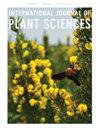基于阿拉斯加北坡一新种的上白垩纪台湾类针叶树多样性的补充证据
IF 1.5
3区 生物学
Q3 PLANT SCIENCES
引用次数: 0
摘要
研究的前提。在阿拉斯加北坡科尔维尔河沿岸发现的3块陆生石灰岩相互连接的岩石碎片表面和内部,保存了10个解剖学上保存的针叶树种子锥体标本,为上白垩纪-新生代期间台湾科柏科的多样化提供了额外的证据。方法。对岩石表面的标本进行了测量和拍照,然后采用醋酸纤维素剥离技术制备了连续的解剖薄片。所选标本的三维图像也使用微计算机断层扫描(micro-CT)捕获。关键的结果。这些种子球果的结构与现存的隐叶台湾相似,它们的球果形状相似,有鳞片状的叶片,螺旋排列和叠瓦状的叶状胚珠复合体(OCs),没有单独的胚珠鳞片尖端,胚珠复合体的数量变化,每个复合体有两个正面位置的有翅种子。然而,突然上翘的OC、OC脉管系统的细节和独特的组织学特征表明,这些种子球果代表了已灭绝的Mukawastrobus属的一个新种。结论。当添加到现有的种子锥化石记录时,新物种Mukawastrobus arnoldii突出了最近的发现,即在柏科早期分化的谱系中,有相当多的白垩纪,古近纪和新近纪的进化,这反映在微妙特征的变化中,这些变化在任何标本中都无法识别,但在保存最完整的标本中。本文章由计算机程序翻译,如有差异,请以英文原文为准。
Additional Evidence for the Diversification of Taiwanioid Conifers in the Upper Cretaceous Based on a New Species from the North Slope of Alaska
Premise of research. Ten anatomically preserved conifer seed cone specimens are preserved on the surfaces of, and within, three interlocking rock fragments of terrestrial limestone discovered as float along the Colville River on the North Slope of Alaska, providing additional evidence for the diversification of taiwanioid Cupressaceae during the Upper Cretaceous–Cenozoic interval. Methodology. Specimens on rock surfaces were measured and photographed, and then serial anatomical thin sections were prepared by the cellulose acetate peel technique. Three-dimensional images of selected specimens were also captured using micro–computed tomography (micro-CT). Pivotal results. The structure of these seed cones is similar to that of living Taiwania cryptomerioides in cone shape, the presence of subtending scalelike leaves, helically arranged and imbricating foliate ovuliferous complexes (OCs), the absence of a separate ovuliferous scale tip, variation in numbers of OCs, and by having two adaxially positioned winged seeds per complex. However, abruptly upturned OC, details of OC vasculature, and distinctive histological features reveal that these seed cones represent a new species of the extinct genus Mukawastrobus. Conclusions. When added to the existing record of fossil seed cones, the new species Mukawastrobus arnoldii highlights the recent discovery that among early-diverging lineages of Cupressaceae, there has been considerable Cretaceous, Paleogene, and Neogene evolution that is reflected by variations among subtle characters that are not recognizable in any but the most completely preserved specimens.
求助全文
通过发布文献求助,成功后即可免费获取论文全文。
去求助
来源期刊
CiteScore
4.50
自引率
4.30%
发文量
65
审稿时长
6-12 weeks
期刊介绍:
The International Journal of Plant Sciences has a distinguished history of publishing research in the plant sciences since 1875. IJPS presents high quality, original, peer-reviewed research from laboratories around the world in all areas of the plant sciences. Topics covered range from genetics and genomics, developmental and cell biology, biochemistry and physiology, to morphology and anatomy, systematics, evolution, paleobotany, plant-microbe interactions, and ecology. IJPS does NOT publish papers on agriculture or crop improvement. In addition to full-length research papers, IJPS publishes review articles, including the open access Coulter Reviews, rapid communications, and perspectives. IJPS welcomes contributions that present evaluations and new perspectives on areas of current interest in plant biology. IJPS publishes nine issues per year and regularly features special issues on topics of particular interest, including new and exciting research originally presented at major botanical conferences.

 求助内容:
求助内容: 应助结果提醒方式:
应助结果提醒方式:


